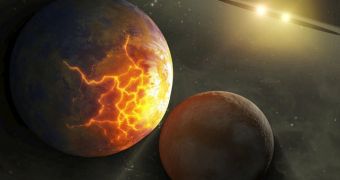According to a new investigation, it would appear that the chances of extraterrestrial life existing on planets around dual star systems are very slim.
This conclusion is based on studies of three such formations, which revealed that the two stars were surrounded by impressively large disks of cosmic dust.
Astronomers hypothesize that these disks were produced after young planets that developed around the cosmic fireballs slammed into each other, annihilating themselves in the process.
It stands to reason that any life form on these planets would have been wiped out in such a scenario. As such, we shouldn't put too much effort in conducting researches into binary systems.
The team of experts that conducted the new work was led by Harvard-Smithsonian Center for Astrophysics (CfA) study researcher Jeremy Drake.
Using the Spitzer Space Telescopes, which surveys the sky in infrared wavelengths, the group looked at three mature, close-orbiting star pairs, and at the dust disks surrounding them.
“This is real-life science fiction. Our data tell us that planets in these systems might not be so lucky – collisions could be common,” Drake reveals.
“It's theoretically possible that habitable planets could exist around these types of stars, so if there happened to be any life there, it could be doomed,” he goes on to say.
One of the stellar pairs that the group investigated really stood out from the crowd. Dubbed RS Canum Venaticorums (RS CVns), this pair was measured to be separated by just 2 million miles.
For comparison, the Earth is separated from the Sun by about 93 million miles, or 150 million kilometers. This proximity means that the two stars in the system are tidally locked.
They always keep the same face pointed at each other, due to the massive gravitational interactions they exert on one another. The Earth and the Moon also represent a tidally-locked system.
“These kinds of systems paint a picture of the late stages in the lives of planetary systems. And it's a future that's messy and violent,” explains scientist Marc Kuchner.
He is based at the NASA Goddard Space Flight Center (GSFC), in Greenbelt, Maryland, and is also a co-author of a new paper detailing the findings. The study is published in the August 19 issue of the esteemed Astrophysical Journal Letters.
The team believes that planets forming around binary star systems are destroyed as the celestial fireballs near each other. This causes disturbances in their gravitational pull.
This means that planets can be knocked off their orbits, and then made to collide with each other, Space reports.

 14 DAY TRIAL //
14 DAY TRIAL //